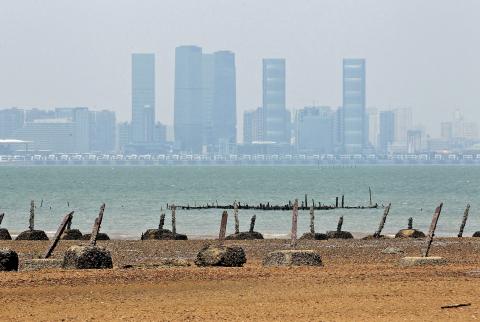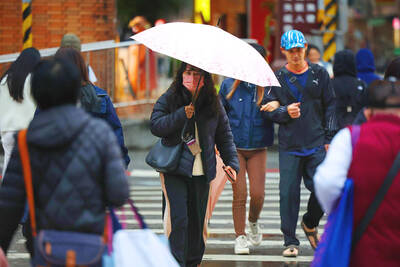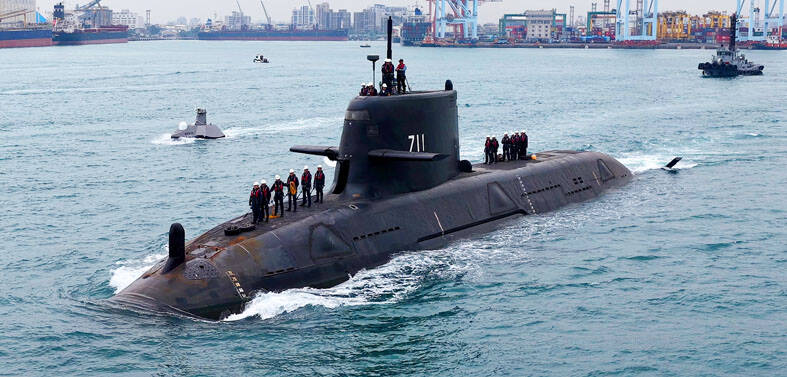Cold War detritus scars the white-sand beach on the island. Concrete barriers meant to halt invading tanks stand sentinel, waiting for an invasion that never came.
In the water, hundreds of rusting, sharpened steel barricades point menacingly toward the bustling Chinese city of Xiamen, whose skyscrapers poke through the midday haze a little more than 4.8km away.
The soldiers who manned the coastal defenses are long gone, though some have been replaced by life-size statues for the benefit of the many tourists who flock to the site. The most imminent danger now is to beachcombers who fail to pick up after their dogs. Signs warn they face a stiff fine: payable in New Taiwan dollars.

Photo: Reuters
Kinmen County’s Lieyu Township (烈嶼), encompassing what is known as Lesser Kinmen Island, is not controlled by the People’s Republic of China, nor is the much larger Kinmen Island nearby, even though both sit on the approaches to one of China’s busiest ports.
The Chinese People’s Liberation Army was never able to wrest control of the strategic islands from former Republic of China leader Chiang Kai-shek (蔣介石), who fled to Taiwan with his Chinese Nationalist Party (KMT) forces in 1949 after losing the Chinese Civil War to Mao Zedong’s (毛澤東) communists.
Chiang, who died in 1975, still watches over the island. A statue of him, doffing his peaked cap, towers over an overgrown athletics field where cows graze. A basketball court and chin-up bars once used by front-line soldiers are slowly surrendering to the lush subtropical vegetation.
Kinmen, formerly called Quemoy, was once a household name in the US. The nationalists and communists engaged in huge artillery duels there in the 1950s, raising tensions among Washington, Beijing and Moscow as then-US president Dwight D. Eisenhower and his secretary of state, John Foster Dulles, vowed to defend Taiwan from attack.
When then-US presidential candidates John F. Kennedy and Richard Nixon were running for head of state in 1960, their disagreement about Quemoy and Matsu, a neighboring archipelago, led to one of the most famous exchanges in their debates.
Now, China and Taiwan exchange volleys of fireworks during the Lunar New Year holiday.
These smaller islands are at a crossroads, borne out by the complicated interplay among the locals, the Taiwanese government and China.
President Tsai Ing-wen’s (蔡英文) Democratic Progressive Party (DPP) took power last month and is focused on the Taiwanese public, who are increasingly uncomfortable with talk over seven decades affirming that Taiwan is part of China.
A poll in February found that 73 percent of Taiwanese surveyed considered themselves Taiwanese, not Chinese, up from 44 percent two decades ago. Among young people, 85 percent consider themselves Taiwanese, the poll found.
Neither Kinmen nor Matsu is geographically part of Taiwan. They are portions of Chinese-controlled Fujian Province that the communists never conquered. Their existence helps to make Taiwan the Republic of China, and people interviewed there, who have prospered as trade and tourism with China have blossomed, have deep ties to China.
“Kinmen people have a very clear sense of their identity,” said Chou Yang-sun (周陽山), a professor who specializes in Chinese affairs at National Quemoy University in Kinmen. “They are Fujianese, but they are also part of the Republic of China — very different from most people in Taiwan, who support independence.”
One such resident is Zhou Ximei, who was born in Fujian’s Ningde County, which from 1988 to 1990 was run by now-Chinese President Xi Jinping (習近平). Zhou married a man from Kinmen, moved there two decades ago and now works in a museum set up in the Jiugong Tunnel, a grotto carved through solid rock to shelter people, boats and supplies during bombardments.
“When you say the Republic of China, there is the word ‘China’ in there as well,” said Zhou, speaking during a lull between boisterous groups of visitors touring the cave. “Chiang Kai-shek came to Taiwan from the mainland, too. I think a good leader needs to seriously ponder if he or she wants Taiwan’s economy to develop and its people to have stable lives.”
Kinmen County prospered as ties between China and Taiwan deepened. In 2001, passenger and trade traffic began between Kinmen and Xiamen. Seven years later, Taiwan opened up direct air, sea and postal links to China. The population in Kinmen boomed, surging to more than 133,000 this year from less than 80,000 a decade ago.
Tourists from China arrive by boat in Kinmen’s port, and a much larger port is being built adjacent to it. A six-story shopping complex, catering to Chinese and billed as Asia’s largest duty-free mall, opened in 2014.
In Taiwan, an hour’s flight away, there has been a different narrative. The economy is contracting and voters who cast their ballots in January, wary that closer ties with China were draining Taiwan of good jobs and giving Beijing more influence, rejected the party that brought better ties with China, Chiang’s own KMT. Tsai leads a party swept into power partly because of concerns about China’s growing shadow over Taiwan.
In December last year, Tsai made a campaign stop in Kinmen, one of the few counties that the DPP wound up losing, and pledged to pour more resources into developing the small islands. As the former head of the government agency that oversees ties with China, she was one of the architects of the “small three links” that in 2001 opened limited passenger, trade and mail connections between Kinmen and Xiamen, and she is not expected to alter the “status quo” that has given such a lift to the local economy.
Despite decades of being on the front lines, including an artillery bombardment that extended more than two decades, people on Kinmen see China not as a threat, but as an opportunity.
In Lieyu, closer ties with China have also had economic consequences, as a massive garrison has dwindled, diminishing a ready market for the island’s shopkeepers.
Soldiers, wearing camouflage uniforms and caps emblazoned with a white sun on a blue field, the national emblem of the Republic of China, mill about the small port where ferries run from Lieyu to China.
However, their small numbers, now in the hundreds, cannot make use of the extensive infrastructure built for the more than 10,000 troops based there decades ago.
Tsai Shu-ta, 59, who, along with his wife, drives a taxi around the less than 15.5km2 that make up Lieyu, recalls the heady days when thousands of soldiers supported a movie theater, whose US-made projector is now on display at a local museum.
Tsai Shu-ta, who has lived his whole life on Lieyu, said he was put off by the DPP’s failure to include Kinmen on its flag — which depicts a green island of Taiwan on a white cross.
He is proud to live in the Republic of China, recalling the propaganda slogans soldiers there broadcast to communist troops across the water. However, he fears a future when Taiwanese might formally move toward independence, which could imperil Kinmen, because Beijing has said that would be grounds for war.
For now, the majority of Taiwanese agree with Tsai Ing-wen that it is best to maintain the “status quo,” the coexistence between the two sides that has kept the peace since the guns finally fell silent in the late 1970s.
If that should ever change, Tsai Shu-ta said, joking and with a chuckle, he has a plan:
“We will return to the mainland,” he said.

SHIPS, TRAINS AND AUTOMOBILES: The ministry has announced changes to varied transportation industries taking effect soon, with a number of effects for passengers Beginning next month, the post office is canceling signature upon delivery and written inquiry services for international registered small packets in accordance with the new policy of the Universal Postal Union, the Ministry of Transportation and Communications said yesterday. The new policy does not apply to packets that are to be delivered to China, the ministry said. Senders of international registered small packets would receive a NT$10 rebate on postage if the packets are sent from Jan. 1 to March 31, it added. The ministry said that three other policies are also scheduled to take effect next month. International cruise ship operators

NUMBERS IMBALANCE: More than 4 million Taiwanese have visited China this year, while only about half a million Chinese have visited here Beijing has yet to respond to Taiwan’s requests for negotiation over matters related to the recovery of cross-strait tourism, the Tourism Administration said yesterday. Taiwan’s tourism authority issued the statement after Chinese-language daily the China Times reported yesterday that the government’s policy of banning group tours to China does not stop Taiwanese from visiting the country. As of October, more than 4.2 million had traveled to China this year, exceeding last year. Beijing estimated the number of Taiwanese tourists in China could reach 4.5 million this year. By contrast, only 500,000 Chinese tourists are expected in Taiwan, the report said. The report

Temperatures are forecast to drop steadily as a continental cold air mass moves across Taiwan, with some areas also likely to see heavy rainfall, the Central Weather Administration (CWA) said. From today through early tomorrow, a cold air mass would keep temperatures low across central and northern Taiwan, and the eastern half of Taiwan proper, with isolated brief showers forecast along Keelung’s north coast, Taipei and New Taipei City’s mountainous areas and eastern Taiwan, it said. Lows of 11°C to 15°C are forecast in central and northern Taiwan, Yilan County, and the outlying Kinmen and Lienchiang (Matsu) counties, and 14°C to 17°C

STEERING FAILURE: The first boat of its class is experiencing teething issues as it readies for acceptance by the navy, according to a recent story about rudder failure The Hai Kun (海鯤), the nation’s first locally built submarine, allegedly suffered a total failure of stern hydraulic systems during the second round of sea acceptance trials on June 26, and sailors were forced to manually operate the X-rudder to turn the submarine and return to port, news Web site Mirror Daily reported yesterday. The report said that tugboats following the Hai Kun assisted the submarine in avoiding collisions with other ships due to the X-rudder malfunctioning. At the time of the report, the submarine had completed its trials and was scheduled to begin diving and surfacing tests in shallow areas. The X-rudder,